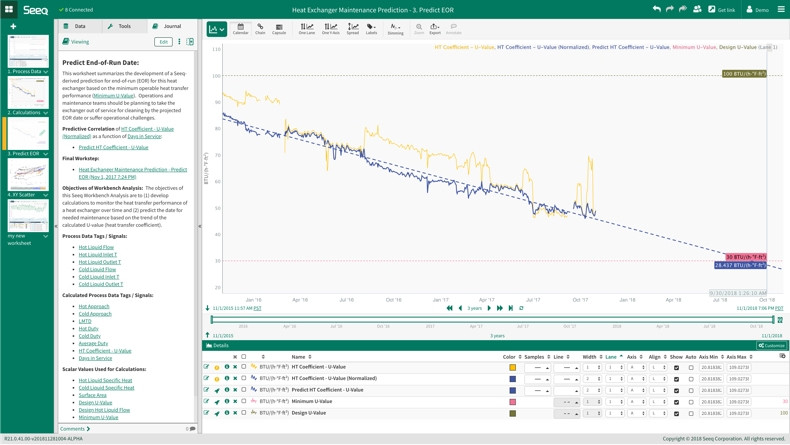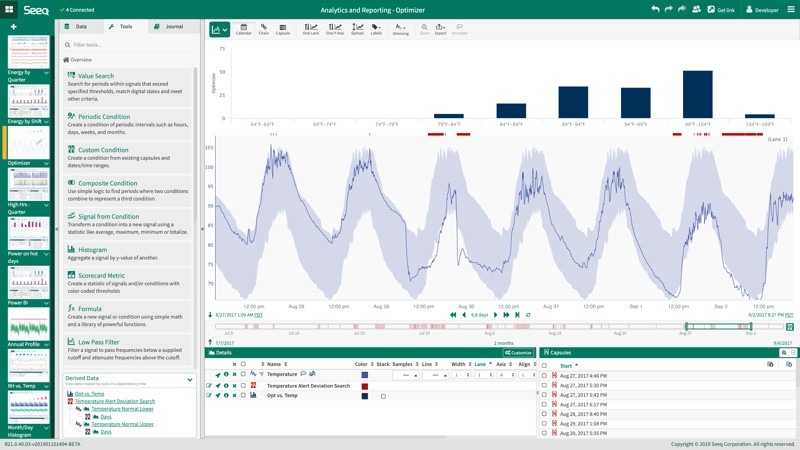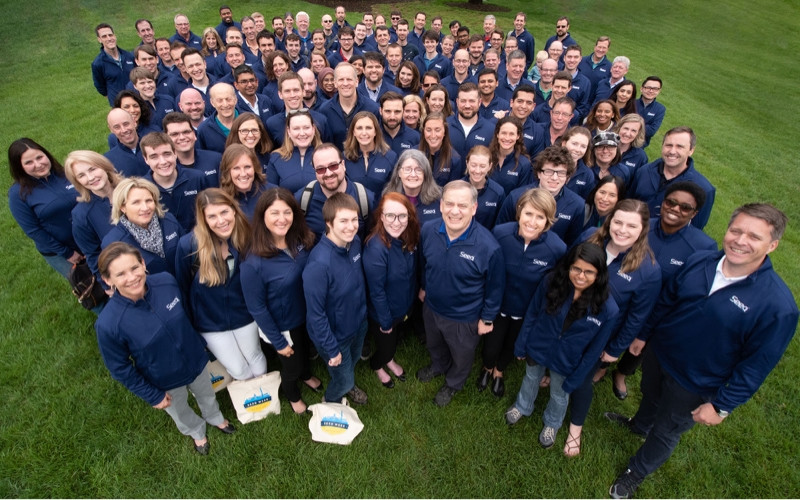“These walls are funny. First you hate ’em. Then you get used to ’em. Enough time passes, you get so you depend on them. That’s institutionalized.” – Red from The Shawshank Redemption
“Institutionalized” is a perfect characterization of the state of today’s industrial operations data infrastructure, which has been plagued by slow hardware and networks, legacy software, and dated IT policies. The “sensorification” of industrial facilities and assets has created massive datasets stuck in isolated data historians and other databases, making extraction and analysis of this data a labor- and time-intensive affair with many still relying on Microsoft Excel spreadsheets to analyze the data. Rather than risk the errors and a lapse in time that can take months, many industrial operational decisions are bypassing analyses altogether and letting intuition guide the way.
“Salvation lies within.” – Warden Samuel Norton, The Shawshank Redemption
Enter Seeq, a company started by industry insiders to address the analytics challenges of process industry customers by integrating with existing data infrastructure through edge-native southbound connectors. Since my first cold-email and conversation with Steve Sliwa, CEO and Co-Founder of Seeq, in 2017, I’ve witnessed this company assume the role as not only a software provider but more of a trusted advisor, helping some of the world’s largest process industry customers transition to Cloud-based advanced analytics and realize greater value from their digital transformation investments.
For this reason and more, I am excited to announce Cisco’s investment in Seeq. To talk more about the company’s solution and business philosophy, I recently sat down with Steve.
Identifying the “data rich, information poor” problem
The Seeq story began when Sliwa was asked to advise Seeq CTO and Co-Founder Brian Parsonnet’s startup, an energy technology business undergoing a reorganization. Looking at their books, Sliwa noticed they were spending an exorbitant amount on process data collection to store time-series data. After digging a little deeper, he found Parsonnet’s company wasn’t alone.
In fact, many process industries, such as oil and gas, food and beverage, pharma and biotech, were collecting huge amounts of oft-unused data at great expense, leaving them feeling “data rich but information poor.”
“They have to have it. It’s almost regulatory as well as operational, but they feel like they’re only scratching the surface of what they can get out of it,” says Sliwa. “So I said, ‘Give me examples of how you get data out of it.’ They said, ‘Well, we extract the data out of historians and we put it into Microsoft Excel.’ I exclaimed, ‘What? You use a finance tool for doing advanced engineering analysis?’”
A former NASA employee, Sliwa knew there had to be a better way. “One of my little jokes about this is I have a Ph.D. in Aerospace Engineering, and I used to work at NASA. So, I was totally certain that this wasn't rocket science and we could fix this.”
In 2013, Sliwa and Parsonnet launched Seeq.
Closing the gap between big data and legacy software
Prior to Seeq’s breakthrough analytics tools, process industry companies would have to wait several weeks to months to get answers to their process optimization questions, which for a typical modern refinery, could mean sifting through a massive volume of process data with antiquated systems.
“A typical modern refinery might have 150,000 to 180,000 sensors that collect data, usually once a second,” says Sliwa. “You have all these tools out there trying to collect and analyze the global financial markets and yet one single refinery generates about that much data.”
Using Excel spreadsheets for analytics and dated legacy software and IT systems, the information was often rife with errors and stale by the time the analyses made their way back to middle management.
Seeq’s analytics tool, on the other hand, is starting to revolutionize the process industry by connecting, contextualizing and analyzing the data in a way that significantly cuts the time between question to answer. What used to take months now takes minutes with a tool that lets businesses spend less time collecting and cleaning data and more time analyzing it.

“Companies used to spend 80% of their time manipulating data and 20% of their time doing analysis. We’ve flipped the equation by letting them spend 80% to 90% of their time actually doing analytics and a very small percentage of their time finding the data and fixing it,” says Sliwa.
Formerly labor-intensive and often forgotten data is now informing key process decisions and being mainstreamed into customers’ digital transformation.

Emphasizing the talent behind the technology
Seeq’s founders knew that service was critical to the company’s success. While many other companies focus solely on their technology for driving the number of software subscriptions they can accrue, Sliwa and Parsonnet understood how integral the service component was to their customers’ digital transformations, as well as Seeq’s own growth.
Technology was only part of the formula; they also needed the industry’s best talent. If they were going to help close the gap between executives and engineers and deliver faster, more valuable business insights, they needed to recruit the industry’s best analytics engineers.
“Once we started making these talented young people available to these businesses, suddenly the magic started to happen,” says Sliwa. “Part of it is the technology, and part of it is the understanding of what the next generation of advanced analytics can be. That’s what’s enabled this rapid growth.”
Now, when Seeq receives testimonials from their customers, they hear how much their clients love not only their analytics tools but also the engineers who are unlocking the keys to their data. “When we do the surveys with our customers,” Sliwa notes, “it’s hard to separate the tools from our talent. They’ll say, ‘Krista was really important for helping us see the value in this.’ Or ‘We want to meet this famous Shamus,’ our analytics engineer.”
What other founders can learn from Seeq’s success
A firm believer that people are what power good startups, Sliwa advises other startup founders to focus on their people resource first. In fact, he has made it his general philosophy to become intimately involved in hiring the first 100 people of a startup as they naturally lay the foundation for future recruiting efforts by setting the tone for how new hires self-identify with the team.
He has also learned when to persist and when to pivot, a balancing act he likens to a famous aviation optimization problem encountered by the U.S. Navy while experimenting with supersonic jets. The pilots were looking to beat the Russians in their “time to climb” as they pulled their jets up at full throttle at 1,000 feet, then 5,000 feet, and then at 10,000 feet.
At the time, the Navy turned to Sliwa’s former professor who devised a way to collect the data. The professor created algorithms, which concluded — counterintuitive to the Naval officers’ belief — that shooting a jet on a straight up trajectory doesn’t necessarily net the fastest end-result time. Rather, according to the professor’s algorithm, the pilots would need to dive downward once they hit the sound barrier, where the drag increases, and then, after picking up the downhill speed, they could shoot up faster in the long run.
“That’s what a manager does,” says Steve. “At some point, when the friction gets too high, you have to find a new path.”
In startup world, that can mean pivoting and finding new directions, even when you really want to keep persisting down your original path. “You have to try and figure out that balance. The time scale changes for when you’re willing to make these pivots during the age of your business,” says Sliwa. “You might do that every few months when you’re early in the business, and then as you grow, it might be every year or every five years.”

Remote-based and ready for COVID and beyond
Having implemented a forward-thinking remote work environment since its founding in 2013, Seeq was more prepared than most to pivot fast in the wake of the COVID-19 pandemic. The startup has not only offered its customers SaaS-based analytics, reporting and collaboration features to help them operate remotely, but also gave its employees the freedom to work without the constraints of a physical office.
The secret, Sliwa says, was building a tech stack and a culture stack that connected its employees with a virtual “Qube” office, complete with avatars and virtual conference rooms where employees and customers can gather on virtual calls or pop in for casual interactions simply by “knocking” on another’s office door.
The startup has also worked hard on making a “conscious investment” in its culture by implementing a variety of online activities, such as “show and tells” in the morning, where employees can share photographs from a recent vacation, a recipe or a sailing experience. They’ve held online Halloween parties, “Seeqret Santa” gift exchanges and virtual game nights.
The communications app Slack also keeps the internal cultural and communications bond strong, with employees giving shout-outs to their colleagues on a Kudos channel. Family is kept in focus with the company’s flexible hours, no tracking of paid time off, and even granting employees a $500 bonus for taking five days off in succession per year.
The biggest way, however, a startup can truly achieve the trust and gratitude of its employees, Sliwa says, is by providing authentic transparency. While a common concern among remote-based employees is not feeling privy to the company’s decision-making or information, Seeq has worked hard to maintain an open book with its employees.
“After every board meeting, I hold an all-hands meeting and go through the full board deck,” says Sliwa. “I give everyone a chance to ask questions and gather their thoughts.”
In the future, the company’s founders only see a greater need for industrial companies migrating their process data to the cloud. While it may entail a slow transition, Seeq will help companies build greater efficiencies in pushing their process data to work harder and soar higher with less friction between big data and legacy software and the engineer and the executive.
